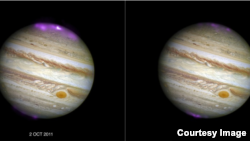Earth is not the only planet in the solar system with aurora borealis, or Northern Lights, according to a new study.
Jupiter, it turns out, also has a similar phenomenon, only the X-ray aurora on the gas giant is “hundreds of times more energetic” and “eight times brighter” than we see here.
They are also larger than the entire surface area of Earth, researchers said.
Researchers say this is the first time Jupiter’s X-ray aurora has been examined thanks to a “giant” solar storm that hit the planet.
The study is based on observations made in October 2011 when a massive solar storm, a coronal mass ejection, reached Jupiter. Using that data, the researchers built a “3D spherical image to pinpoint the source of the X-ray activity.”
“In 2000, one of the most surprising findings was a bright ‘hot spot’ of X-rays in the aurora which rotated with the planet,” said William Dunn, a PhD candidate at University College London Mullard Space Science Laboratory and lead author of the new study.
“It pulsed with bursts of X-rays every 45 minutes, like a planetary lighthouse. When the solar storm arrived in 2011, we saw that the hot spot pulsed more rapidly, brightening every 26 minutes. We’re not sure what causes this increase in speed but, because it quickens during the storm, we think the pulsations are also connected to the solar wind, as well as the bright new aurora.”
They said the study sheds light on the relationship between Jupiter’s magnetic field (a.k.a. magnetosphere) and solar wind. Earth’s Northern Lights, too, are caused by the interaction of solar wind with the planet’s magnetosphere.
“There’s a constant power struggle between the solar wind and Jupiter’s magnetosphere,” said Dunn. “We want to understand this interaction and what effect it has on the planet.
“By studying how the aurora changes, we can discover more about the region of space controlled by Jupiter’s magnetic field, and if or how this is influenced by the sun. Understanding this relationship is important for the countless magnetic objects across the galaxy, including exoplanets, brown dwarfs and neutron stars.”
When giant solar storms arrive at Jupiter’s magnetosphere, they push its boundary by 2 million kilometers. This, researchers say, causes the planet’s X-ray aurora.
“Comparing new findings from Jupiter with what is already known for Earth will help explain how space weather is driven by the solar wind interacting with Earth’s magnetosphere,” said Graziella Branduardi-Raymont, an astrophysicist at UCL Mullard Space Science Laboratory and a co-author of the study. “New insights into how Jupiter’s atmosphere is influenced by the Sun will help us characterize the atmospheres of exoplanets, giving us clues about whether a planet is likely to support life as we know it.”
The study was published in the Journal of Geophysical Research – Space Physics.









